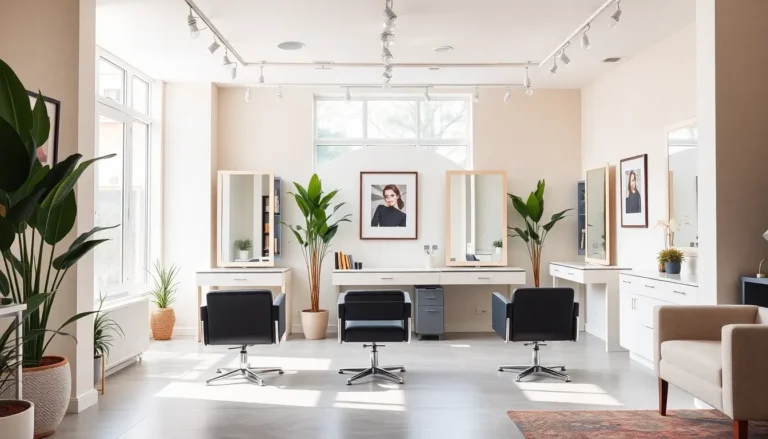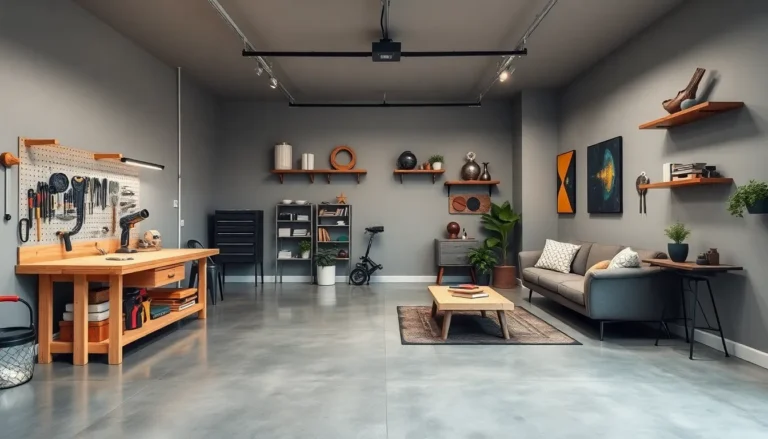Art Deco details are like the stylish accessories of architecture and design, adding flair and personality to everything they touch. Imagine walking into a room that feels like a glamorous 1920s speakeasy or a chic Parisian café—now that’s the magic of Art Deco. This design movement, with its bold geometric patterns and luxurious materials, has a way of making the ordinary feel extraordinary.
Table of Contents
ToggleOverview of Art Deco Details
Art Deco details reflect the movement’s luxurious essence and distinct stylistic features. Geometric shapes dominate the design, showcasing symmetry and repetition. Bold colors and rich materials are often central to creating sophisticated atmospheres.
Buildings frequently incorporate ornate façades, intricate moldings, and polished surfaces that capture the period’s elegance. Decorative elements such as zigzags, chevrons, and stylized floral motifs enhance visual depth and interest.
Furniture displays craftsmanship through streamlined forms and elegant finishes. Lighting fixtures, often made from metal or glass, present unique silhouettes, enhancing the overall aesthetic.
Textiles frequently feature opulent patterns and textures, contributing to the richness of Art Deco interiors. Wall coverings, rugs, and upholstery often exhibit celebrating intricate designs that play upon the movement’s glamorous spirit.
Art Deco objects, like ceramics and glassware, frequently showcase precision and elegance in their craftsmanship. These items, marked by bold forms and intricate details, demonstrate how everyday items embody design excellence.
Architectural landmarks often epitomize Art Deco’s grandeur, featuring iconic structures such as the Chrysler Building and the Palais de Chaillot. Each element, from ornamentation to layout, signifies a connection to modernity and progress during the 1920s and 1930s.
The combination of these details creates an immersive environment, inviting appreciation for the era’s artistic vision. Art Deco’s allure persists, continuing to inspire contemporary designers and enthusiasts alike.
Key Characteristics of Art Deco
Art Deco is defined by its distinct visual elements, showcasing a style that merges elegance with modernity. Key characteristics include geometric patterns, bold colors, and luxurious materials.
Geometric Patterns
Geometric patterns dominate Art Deco design, featuring strong lines and angular shapes. Triangles, zigzags, and chevrons frequently appear, creating dynamic visual interest. In architecture, these designs often manifest in ornate façades and decorative moldings. Furniture also highlights these motifs, enhancing the overall aesthetic of interiors. Repetition ensures a cohesive look, while symmetry imparts balance and sophistication.
Bold Colors
Bold colors play a vital role in Art Deco’s appeal, evoking a sense of luxury and glamour. Deep hues like emerald green, sapphire blue, and rich burgundy often create impactful contrasts. Metallic shades, particularly gold and silver, add a touch of opulence to both decor and fashion. Color combinations often emphasize the geometric designs, enhancing their visual prominence. Vibrancy in color choices helps define the era, making Art Deco designs instantly recognizable.
Luxurious Materials
Luxurious materials significantly contribute to the richness of Art Deco design. High-quality woods, polished metals, and marble are frequently employed in both architecture and furniture. Additionally, textiles such as silk and velvet add sumptuousness to interiors, enhancing tactile experiences. Glass, particularly in intricate lighting fixtures and decorative items, showcases craftsmanship and elegance. The use of these materials reflects a commitment to quality, showcasing the era’s dedication to aesthetic excellence.
Iconic Art Deco Details in Architecture
Art Deco architecture features striking details that showcase creativity and innovation. Geometric forms dominate buildings, creating dynamic and eye-catching silhouettes.
Buildings and Structures
Iconic structures such as the Chrysler Building and the Empire State Building exemplify Art Deco’s architectural brilliance. Vertical lines and spires establish a sense of height and grandeur. Facades often display elaborate ornamentation, including motifs inspired by nature or technology, enhancing the visual interest. Decorative friezes embellish exterior walls, while materials like limestone and stainless steel add sophistication and durability. Each building integrates luxury and modernity, contributing to the urban landscape.
Interior Design Elements
Art Deco interiors embrace bold colors and rich textures. Luxurious fabrics like silk, velvet, and leather create opulent atmospheres. Decorative lighting, including sculptural chandeliers and wall sconces, provides a warm and inviting glow. Furniture pieces often feature streamlined designs with rich wood grains and polished metals. Accessories such as ceramics and glassware reflect artful craftsmanship and elegance. With these elements, Art Deco interiors invite comfort and sophistication, transforming spaces into stunning showcases of the style’s essence.
Famous Examples of Art Deco Details
Art Deco encompasses numerous iconic examples that showcase its distinctive style and opulence.
The Chrysler Building
The Chrysler Building stands as a hallmark of Art Deco architecture in New York City. Its stainless steel spire reaches 1,046 feet, embodying both height and elegance. Finely crafted gargoyles adorn the structure, reminiscent of classic automotive motifs, illustrating a connection to the era’s industrial advancements. Intricate geometric patterns embellish the lobby, featuring a dazzling mural that enhances the overall experience. This landmark represents not just architectural brilliance but also a blend of artistry and engineering that defines the Art Deco movement.
Art Deco Furniture
Art Deco furniture exemplifies luxurious design and meticulous craftsmanship. Geometric forms dominate the style, with streamlined silhouettes that create visually striking pieces. Rich woods like mahogany and ebony feature prominently, often paired with opulent materials like leather and silk. Upholstered chairs embody bold colors, enhancing visual appeal. Decorative accents, including inlays and lacquer finishes, showcase attention to detail. Each piece contributes to creating sophisticated interiors, reflecting elegance while maintaining functionality. Art Deco furniture serves as a testament to an era that celebrated both style and innovation.
Modern Interpretations of Art Deco Details
Contemporary designers draw inspiration from Art Deco, reimagining its classic elements for modern aesthetics. Geometric patterns find their way into wallpaper and textiles, enhancing spaces with a nostalgic yet fresh feel. Luxurious materials, such as marble and brass, complement these patterns, creating a blend of old and new.
Architects incorporate Art Deco details in public and commercial spaces, showcasing the style’s enduring appeal. Buildings feature sleek lines and ornate entrances, reminiscent of iconic structures like the Chrysler Building. Interiors highlight vibrant colors and rich textures, blending hard and soft elements that reflect sophistication.
Furniture design also celebrates these interpretations, with streamlined silhouettes and striking materials. Iconic pieces use Art Deco motifs like chevrons and sunbursts, elevating everyday objects to artful statements. Lighting fixtures adopt sculptural forms, providing both illumination and visual interest.
Even in smaller accents, such as mirrors and accessories, the essence of Art Deco emerges. Textured fabrics and bold prints decorate cushions and throws, creating opulent yet approachable environments. Designers embrace the elegance of this style, enhancing modern living with a touch of historical glamour.
Art Deco inspired designs resonate across various fields, including fashion and graphic design. Clothing features luxurious fabrics and geometric prints that echo the era’s style. Logos and marketing materials often adopt Art Deco typography, reflecting a timeless sophistication that appeals to contemporary consumers.
In sum, modern interpretations of Art Deco details sustain its legacy by blending historical elegance with modern functionality and aesthetic innovation. This adaptability ensures that the spirit of Art Deco continues to influence today’s design landscape.
Art Deco details continue to captivate with their unique blend of elegance and modernity. This design movement’s influence remains evident in contemporary architecture and interiors. The bold geometric patterns and luxurious materials that defined the era still inspire designers today.
As a testament to its lasting appeal, Art Deco’s rich textures and striking colors find their way into modern homes and public spaces. By embracing these timeless elements, today’s designers pay homage to a period that celebrated innovation and craftsmanship.
Ultimately, Art Deco’s legacy thrives in the creative expressions of the present, ensuring that its allure will never fade.






